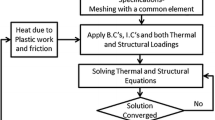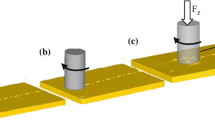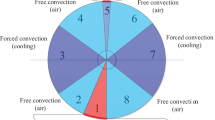Abstract
The finite element method (FEM) is one of the most applicable mathematical analytic methods of rolling processes and is also an efficient method for analyzing coupled heat transfer. Thermal analysis of cold rolling process is not frequently used due to the widespread assumption of insignificant impact during rolling process. This research focuses on the development of coupled thermo-mechanical 2-D FE model analysis approach to study the thermal influence and varying coefficient of friction during the industrial cold rolling process of AA8015 aluminum alloy. Both deformable-rigid and deformable-deformable rigid contact algorithms were examined in the 2-D FE model. Findings revealed that temperature distribution in the roll bite rises steadily in a stepwise manner. The deformable-deformable contact algorithm is the best investigations of thermal behavior of the rolled metal and work rolls necessary for typical application in work roll design. The predicted roll separating force is validated with industrial measurements.
Similar content being viewed by others
References
Lenard JG (2007) Primer on flat rolling, 1st edn. Elsevier Science
Singh RV (2011) Aluminium rolling: processes, principles & applications. McGraw-Hill Education, New Delhi
Stephenson DA (1983) Lubrication in cold strip rolling. Wear 92(2):293–311
Keife H, Sjogren C (1994) A friction model applied in the cold rolling of aluminum strips. Wear 179:137–142
Lenard JG, Zhang S (1997) A study of frction during the lubricated cold rolling of an aluminium alloy. J Mater Process Technol 72:293–301
McConnell C, Lenard JG (2000) Friction in cold rolling of a low carbon steel with lubricants. J Mater Process Technol 99:86–93
Jiang ZY, Xiong SW, Tieu AK, Wang QJ (2008) Modelling of the effect of friction on cold strip rolling. J Mater Process Technol 201:85–90
Wilson WRD, Chang CT, Sa CY (1989) Interface temperatures in cold rolling. J Mater Shap Technol 6:229–240
Galantucci LM, Tricarico L (1999) Thermo-mechanical simulation of a rolling process with an FEM approach. J Mater Process Technol 92-93:494–501
Louaisil K, Dubar M, Deltombe R, Dubois A, Dubar L (2008) Simulation of interface temperature and control of lubrication in the study of friction and wear in cold rolling. Int J Mater Form 1(1239):1242
Azushima A (2016) Tribology in sheet rolling technology. Springer International Publishing, Switzerland
Liu YJ, Tieu AK, Wang DD, Yuen WYD (2001) Friction measurement in cold rolling. J Mater Process Technol 111:142–145
Shaw MC, Ber A, Mamin PA (1960) Friction characteristics of sliding surfaces undergoingsubsurface plastic flow. J Basic Eng 82(2):342–345
Banerji A, Rice WB (1972) Experimental determination of normal pressure and friction stress in the rolling gap during cold rolling. Annals of the CIRP 21:53–54
Al-Salehi FAR, Firbank TC, Lancaster PB (1973) An experimental determination of the roll pressure distribution in cold rolling. Int J Mech Sci 15:693–710
Nyahumwa C, Jeswiet J (1991) A friction sensor for sheet-metal rolling. CIRP Annals- Manufacturing Technology 40(1):231–233
Jeswiet J (1993) A sensor for measuring metal deformation interface forces. J Mater Process Technol 39(3–4):251–268
Azushima A, Kudo H (1995) Direct observation of contact behaviour to interpret the pressure dependence of the coefficient of friction in sheet metal forming. CIRP Annals- Manufacturing Technology 44(1):209–212
Tieu AK, Liu YJ (2004) Friction variation in the cold-rolling process. Tribol Int 37:177–183
Jiang ZY, Tieu AK, Zhang XM (2004) Finite element modelling of mixed film lubrication in cold strip rolling. J Mater Process Technol 151(1–3):242–247
Liu QY, Jin XS, Zhou ZR (2005) An investigation of friction characteristic of steels under rolling -sliding condition. Wear 259(1–6):439–444
Ghosh MK, Majumdar BC, Sarangi M (2014) Fundamentals of fluid film lubrication. McGraw-Hill Education, New Delhi
ASTM Standards: E8/E8M-15a. Standard test methods for tension testing of metallic materials
Knitel S, Spatig P, Seifert HP (2016) An inverse method based on finite element model to derive the plastic flow properties from non-standard tensile specimens of Eurofer97 steel. Nucl Mater Energy 9:311–316
Prihod’ko I, Krot P, Solov’yov K, Parsenyuk E, Chernov P, Pimenov V et al (2006) Vibration monitoring system and the new methods of chatter early diagnostics for tandem mill control. Proceedings of international conference London, United Kingdom, p 87–106
Montmitonnet P (2006) Hot and cold strip rolling process. Comput Methods Appl Mech Eng 195(48–49):6604–6625
Madhusudana CV (2014) Thermal contact conductance, 2nd edn. Springer International Publishing, Switzerland
Timothy SP, Yiu HL, Fine JM, Ricks RA (1991) Simulation of single pass of hot rolling deformation of aluminium alloy by plane strain compression. J Mater Sci Technol 7(3):195–201
Pietrzyk M, Lenard JG (1989) A study of thermal-mechanical modeling of hot flat rolling. Journals of Materials Shaping Technology 7(2):117–126
Lienhard JH IV, Lienhard V, J. H. (2003) A heat transfer textbook, 3rd edn. Phlogiston Press, Cambridge
Agilent Technologies (2007) Material expansion coefficients. Agilent laser and optics: User’s manual, volume I. Agilent Technologies Inc., California, pp 280–290 http://www.uzimex.cz/soubory/20080403_laser_optika_cast_1.pdf
Efunda (2017) Thermal conductivity: Aluminum. Retrieved 7/15, 2017, from http://www.efunda.com/materials/elements/TC_Table.cfm?Element_ID=Al
Kaye&Label (2017) Thermal conductivities. Retrieved 7/15, 2017, from http://www.kayelaby.npl.co.uk/general_physics/2_3/2_3_7.html
Acknowledgements
The authors want to thank the University of Johannesburg and the Council for Scientific and Industrial Research (CSIR) South Africa for their support of this research. The authors would also like to express gratitude toward Tower Aluminum, Nigeria, for their contribution in providing the aluminum samples and data collection. Special thanks to the factory manager for his hospitality. The finite element simulations were performed on assets provided by Lulea University of Technology, Sweden.
Author information
Authors and Affiliations
Corresponding author
Rights and permissions
About this article
Cite this article
Olaogun, O., Edberg, J., Lindgren, LE. et al. Heat transfer in cold rolling process of AA8015 alloy: a case study of 2-D FE simulation of coupled thermo-mechanical modeling. Int J Adv Manuf Technol 100, 2617–2627 (2019). https://doi.org/10.1007/s00170-018-2811-2
Received:
Accepted:
Published:
Issue Date:
DOI: https://doi.org/10.1007/s00170-018-2811-2




